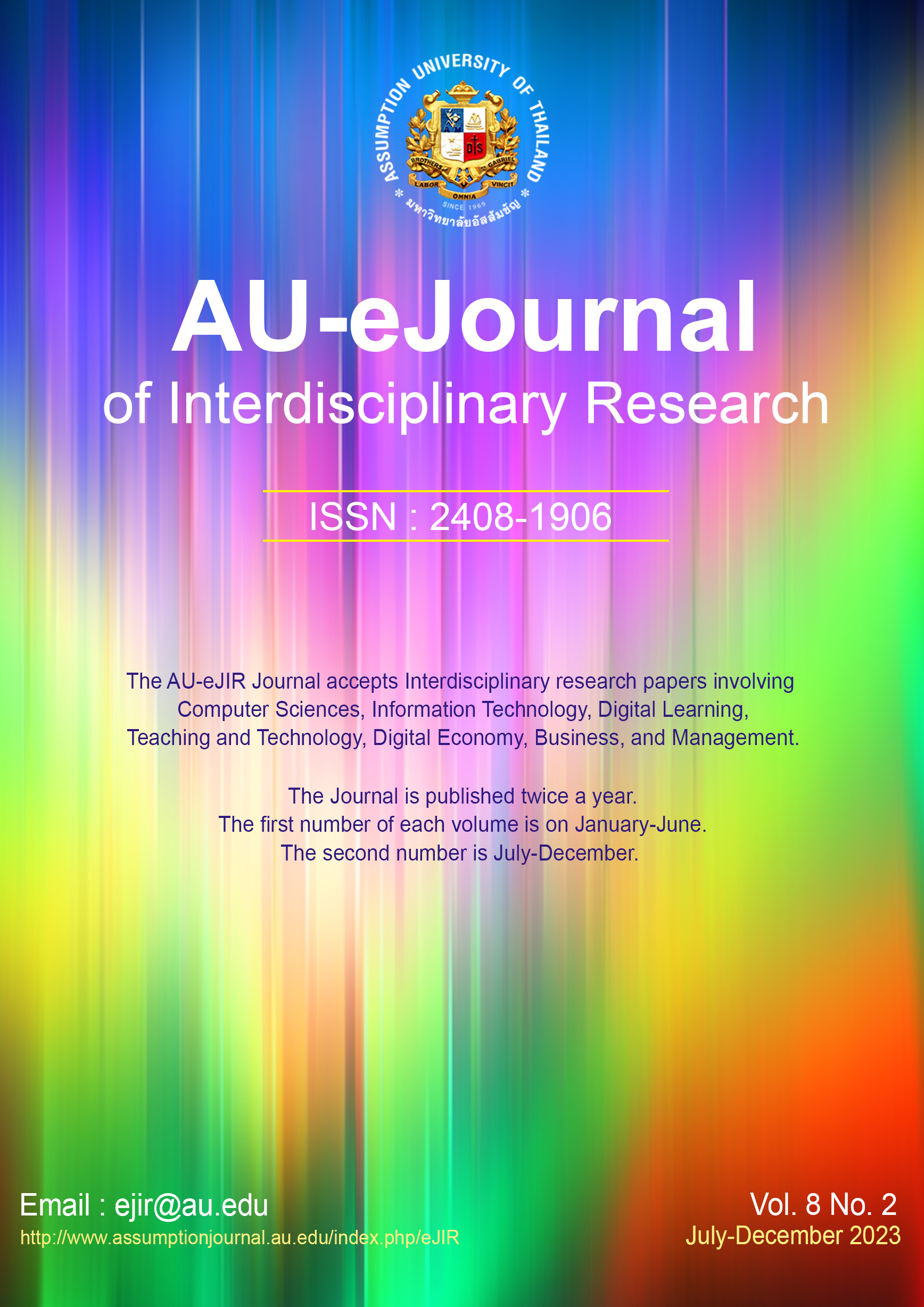Factors Influencing Visual Communication Design Students’ Satisfaction Toward Tencent Meeting of Online Class at a Public University in Chengdu, China
Keywords:
Course design, Online Class, Student Self-Engagement, Students’ Satisfaction, Tencent MeetingAbstract
Purpose: The purpose of this paper is to examine the factors influencing visual communication design students’ satisfaction toward Tencent Meeting of online class at a public university in Chengdu, China. Research design, data and methodology: The research methodology used in this study was quantitative research and questionnaire to collect data. Based on the review of prior literature, a model of teacher self-efficacy, student self-regulation, student engagement, and course design/structure pairs with visual communication design students’ satisfaction with using Tencent Meetings for online classes was designed. Sixty valid questionnaires were collected from third-year undergraduate students majoring in visual communication design at a public university in Chengdu. Multiple linear regression was used to analyze the data. Results: The results of the study showed that students’ participation in course design/structure was statistically significant on students’ Tencent conferencing for online classroom satisfaction, p < 0.001. furthermore, the test also found that Teachers’ self-efficacy (β = 0.055, p = 0.487 ), and student self-regulation (β = 0.056, p = 0.492) did not significantly influence Students’ satisfaction towards online class using Tencent meeting. Conclusions: The results of the study showed that most of the visual communication design students were satisfied with the use of Tencent meeting for the online class, and the students could learn, communicate, and collaborate well through this platform, which provided a satisfactory learning experience for the students. Secondly reasonable course design/structure and active student participation are the key factors for student satisfaction, emphasizing the important impact of course design and student participation on online courses, which can be improved through improvements in these areas.
References
Alibakhshi, G., Nikdel, F., & Labbafi, A. (2020). Exploring the consequences of teachers’ self-efficacy: A case of teachers of English as a foreign language. Asian-Pacific Journal of Second and Foreign Language Education, 5(1).
https://doi.org/10.1186/s40862-020-00102-1
Do, M. N., & Lai, P. H. (2023). The mediating role of self-efficacy in the relationship between the online learning environment and academic self-regulation. Journal of Applied Research in Higher Education, Vol. ahead-of-print No. ahead-of-print.
https://doi.org/10.1108/jarhe-11-2022-0371
Eom, S. B., & Ashill, N. (2016). The Determinants of Students’ Perceived Learning Outcomes and Satisfaction in University Online Education: An Update. Decision Sciences Journal of Innovative Education, 14(2), 185-215.
https://doi.org/10.1111/dsji.12097
Gray, P. A., & DiLoreto, M. (2016). The Effects of Student Engagement, Student Satisfaction, and Perceived Learning in Online Learning Environments. NCPEA International Journal of Educational Leadership Preparation, 11(1). https://eric.ed.gov/?id=EJ1103654
Hair, J. F., Black, W. C., Babin, B. J., & Anderson, R. E. (2010). Multivariate Data Analysis (7th Ed.). Pearson.
Hamdan, K. M., Al-Bashaireh, A. M., Zahran, Z., Al-Daghestani, A., AL-Habashneh, S., & Shaheen, A. M. (2021). University students' interaction, internet self-efficacy, self-regulation and satisfaction with online education during pandemic crises of COVID-19 (SARS-Cov-2). International Journal of Educational Management, 35(3), 713-725.
https://doi.org/10.1108/ijem-11-2020-0513
Huang, M., Shi, Y., & Yang, X. (2021). Emergency remote teaching of English as a foreign language during COVID-19: Perspectives from a university in China. International Journal of Educational Research and Innovation (IJERI), 15, 400-418. https://doi.org/10.46661/ijeri.5351
Kim, S., & Kim, D. (2021). Structural relationship of key factors for student satisfaction and achievement in asynchronous online learning. Sustainability, 13(12), 6734.
https://doi.org/10.3390/su13126734
Lan, W. C., Xiang, C. C., & Feng, D. P. (2022). Influencing Factors of Behavioral Intention and Satisfaction of Online Learning Among Undergraduates in Chengdu University of China. Journal of Suvarnabhumi Institute of Technology (Humanities and Social Sciences), 8(2), 383-400.
https://so04.tci-thaijo.org/index.php/svittj/article/view/258379
Landrum, B. (2020). Examining students’ confidence to learn online, self-regulation skills and perceptions of satisfaction and usefulness of online classes. Online Learning, 24(3), 128-146. https://doi.org/10.24059/olj.v24i3.2066
Maini, R., Sehgal, S., & Agrawal, G. (2021). Todays’ digital natives: an exploratory study on students’ engagement and satisfaction towards virtual classes amid COVID-19 pandemic. The International Journal of Information and Learning Technology, 38(5), 454-472.
Mojavezi, A., & Tamiz, M. P. (2012). The impact of teacher self-efficacy on the students’ motivation and achievement. Theory and Practice in Language Studies, 2(3), 483-491.
https://doi.org/10.4304/tpls.2.3.483-491
Muzammil, M., Sutawijaya, A., & Harsasi, M. (2020). Investigating student satisfaction in online learning: The role of student interaction and engagement in distance learning university. Turkish Online Journal of Distance Education, 21(Special Issue-IODL), 88-96.
https://doi.org/10.17718/tojde.770928
Park, S., & Kim, N. H. (2021). University students’ self-regulation, engagement and performance in flipped learning. European Journal of Training and Development, 46(1/2), 22-40.
https://doi.org/10.1108/ejtd-08-2020-0129
Pimentel, J. L. (2010). A note on the usage of Likert Scaling for research data analysis. USM R&D Journal, 18(2), 109-112.
Sayibu, M., Jianxun, C., Akintunde, T. Y., Hafeez, R. O., Koroma, J., Amosun, T. S., & Shahani, R. (2021). Nexus between students’ attitude towards self-learning, Tencent APP usability, mobile-learning, and innovative performance. Social Sciences & Humanities Open, 4(1) , 100217.
https://doi.org/10.1016/j.ssaho.2021.100217
She, L., Ma, L., Jan, A., Sharif Nia, H., & Rahmatpour, P. (2021). Online learning satisfaction during COVID-19 pandemic among Chinese University students: The serial mediation model. Frontiers in Psychology, 12.
https://doi.org/10.3389/fpsyg.2021.743936
Taber, K. S. (2018). The use of Cronbach’s alpha when developing and reporting research instruments in science education. Research in Science Education, 48(6), 1273-1296.
Tang, Y. M., Chen, P. C., Law, K. M., Wu, C., Lau, Y., Guan, J., He, D., & Ho, G. (2021). Comparative analysis of student’s live online learning readiness during the coronavirus (COVID-19) pandemic in the higher education sector. Computers & Education, 168, 104-211.
https://doi.org/10.1016/j.compedu.2021.104211
Tavakol, M., & Dennick, R. (2011). Making sense of Cronbach’s Alpha. International Journal of Medical Education, 2, 53-55.
https://doi.org/10.5116/ijme.4dfb.8dfd
Wang, Y., Cheng, Y., & Yang, J. (2021). Perception of students’ learning experience on an online course designed by APT model during COVID-19 outbreak. 2021 IEEE 24th International Conference on Computer Supported Cooperative Work in Design (CSCWD).





